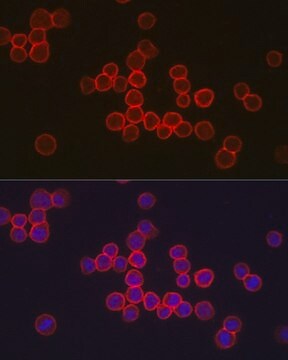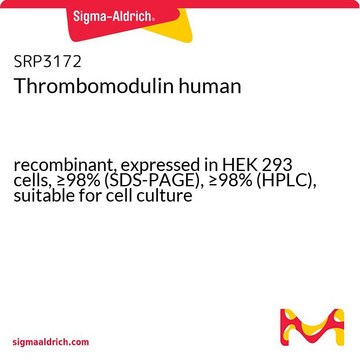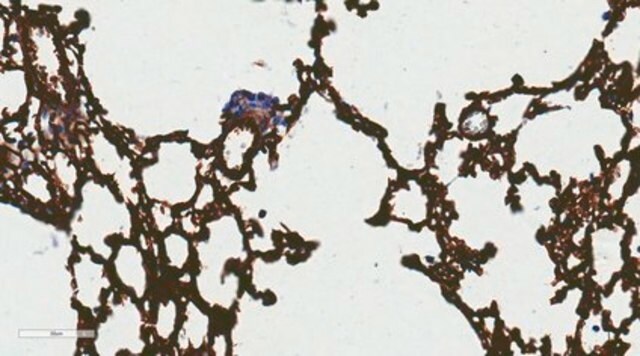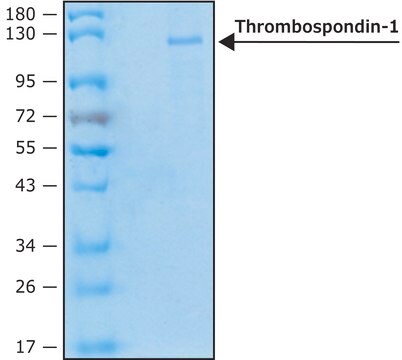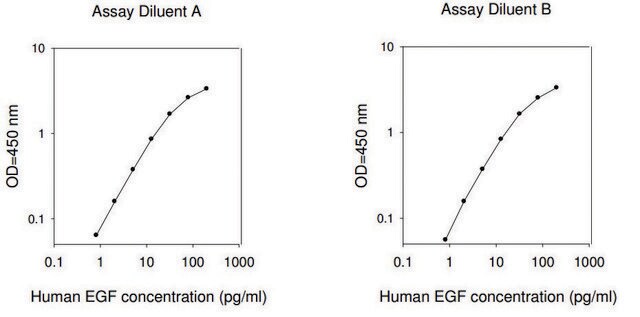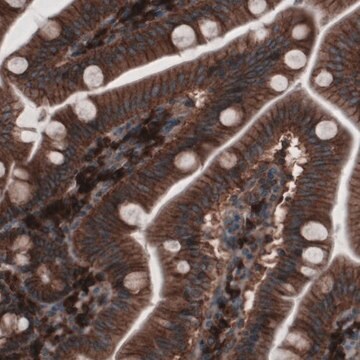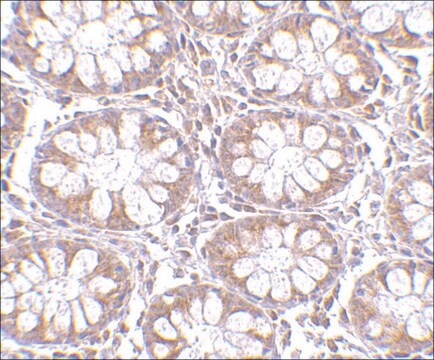MABS1245
Anti-Thrombomodulin Antibody, clone 273-34A
clone 273-34A, from rat
Synonim(y):
TM, Thrombomodulin, Fetomodulin, CD141
About This Item
Polecane produkty
pochodzenie biologiczne
rat
Poziom jakości
forma przeciwciała
purified antibody
rodzaj przeciwciała
primary antibodies
klon
273-34A, monoclonal
reaktywność gatunkowa
mouse, human
metody
ELISA: suitable
electron microscopy: suitable
immunohistochemistry (formalin-fixed, paraffin-embedded sections): suitable
immunoprecipitation (IP): suitable
izotyp
IgG2aκ
numer dostępu NCBI
numer dostępu UniProt
Warunki transportu
wet ice
docelowa modyfikacja potranslacyjna
unmodified
informacje o genach
human ... THBD(7056)
mouse ... Thbd(21824)
Opis ogólny
Immunogen
Zastosowanie
Immunoprecipitation Analysis: Representative lots immunoprecipitated the 112 kDa thrombomodulin from normal mouse lung fibroblasts (NMLF), but not Line 1 mouse lung carcinoma cells (Kennel, S.J., et al. (1988). Lab. Invest. 59(5):692-701; Kennel, S.J., et al. (1987). Exp. Mol. Pathol. 47(1):110-124).
Immunohistochemistry Analysis: A representative lot detected upregulated thrombomodulin immunoreactivity associated with the neoepidermis during wound healing using formalin-fixed, paraffin-embedded mouse skin sections (Peterson, J.J., et al. (1999). Am. J. Pathol. 155(5): 1569–1575).
Immunohistochemistry Analysis: Representative lots detected epithelium thrombomodulin immunoreactivity in paraffin-embedded mouse lung sections (Ford, V.A., et al. (1992). J. Biol. Chem. 267(8):5446-5450; Kennel, S.J., et al. (1987). Exp. Mol. Pathol. 47(1):110-124).
Immunohistochemistry Analysis: A representative lot detected thrombomodulin immunoreactivity associated with capillary endothelial cells by fluorescent immunohistochemistry using frozen mouse lung sections (Kennel, S.J., et al. (1987). Exp. Mol. Pathol. 47(1):110-124)
ELISA Analysis: Representative lots were used as the capture antibody for the detection of thrombomodulin in mouse tissue samples by sandwich ELISA using clone 411-201B (Cat. No. MABS1273) as the detection antibody, followed by an HRP-conjugated secondary antibody, or by sandwich radio-immunoassay using 125I-labeled clone 411-201B as the detection antibody (Isermann, B., et al. (2001). Development. 128(6):827-838; Conway, E.M., et al. (1999). Blood. 93(10):3442-3450; Weiler-Guettler, H., et al. (1996). Circ. Res. 78(2):180-187; Ford, V.A., et al. (1992). J. Biol. Chem. 267(8):5446-5450).
Electron Microscopy Analysis: Representative lots detected thrombomodulin immunoreactivity associated with capillary endothelial cells by EM using frozen mouse lung sections (Kennel, S.J., et al. (1988). Lab. Invest. 59(5):692-701; Kennel, S.J., et al. (1987). Exp. Mol. Pathol. 47(1):110-124).
Western Blotting Analysis: A representative lot detected purified thrombomodulin (P112) from normal mouse lung fibroblasts (NMLF) (Kennel, S.J., et al. (1988). Lab. Invest. 59(5):692-701).
Signaling
Signaling Neuroscience
Jakość
Immunohistochemistry Analysis: A 1:50 dilution of this antibody detected Thrombomodulin in mouse heart tissue.
Opis wartości docelowych
Postać fizyczna
Przechowywanie i stabilność
Inne uwagi
Oświadczenie o zrzeczeniu się odpowiedzialności
Nie możesz znaleźć właściwego produktu?
Wypróbuj nasz Narzędzie selektora produktów.
Kod klasy składowania
12 - Non Combustible Liquids
Klasa zagrożenia wodnego (WGK)
WGK 2
Temperatura zapłonu (°F)
Not applicable
Temperatura zapłonu (°C)
Not applicable
Certyfikaty analizy (CoA)
Poszukaj Certyfikaty analizy (CoA), wpisując numer partii/serii produktów. Numery serii i partii można znaleźć na etykiecie produktu po słowach „seria” lub „partia”.
Masz już ten produkt?
Dokumenty związane z niedawno zakupionymi produktami zostały zamieszczone w Bibliotece dokumentów.
Nasz zespół naukowców ma doświadczenie we wszystkich obszarach badań, w tym w naukach przyrodniczych, materiałoznawstwie, syntezie chemicznej, chromatografii, analityce i wielu innych dziedzinach.
Skontaktuj się z zespołem ds. pomocy technicznej